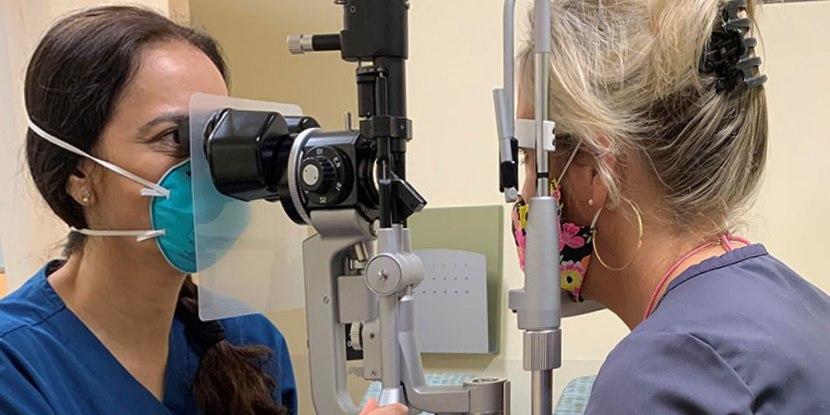Changes in ophthalmology due to Coronavirus disease (COVID-19)
Since the 31st of December 2019, the whole world has been adjusting to the new reality. With the spread of the Coronavirus disease (also known as COVID-19) and the complete shutdown of countries, most businesses and industries are forced to look for new alternative methods of functioning.
The Coronavirus disease is transmitted through droplets from coughing or sneezing and other secretions. Knowing that ophthalmologists rely heavily on physical examination during patient consultation, there are serious concerns about the closeness of the patient and the ophthalmologist during examination. With that being said, COVID-19 leaves us with many questions. How do we protect ourselves and our patients from it? What can we expect long-term? Will there be any major changes in ophthalmology?
COVID-19: Accelerating the move to digital ophthalmology processes
While working to minimize the spread of COVID 19, normal procedures such as having patients fill out pre-visit paperwork will likely be changed to web-based services allowing forms to be filled out and screened remotely, limiting the amount of time the patient has to spend on site.
With the onset of social distancing procedures and physical space restrictions, comes another issue – more patients and less doctors. In order to maximize the efficiency in which patients are treated – it will be essential for ophthalmologists to adapt to using digital systems to streamline their workflow.
Previously, we collected data from devices such as the OCTS, visual field machines, and optical biometers. We’re now in a time when having data before an appointment can save not just time but also save from the spread of viruses. It is very important to ensure that the equipment you utilize has the data capabilities to treat patients from the diagnosis stage to the treatment stage. When diagnosing patients, use digital microscopes that allow easy data access.
Most definitely there will be more practices of remote monitoring of patients. Imagine the opportunity of being able to check your patient’s progress and write a text if they need to come in for an appointment or even better: if there is no need to show up for their appointment. These are proactive measures to be able to manage patients appropriately and keep operating costs down.
Expanding your optometry practice is very important nowadays, especially if you are willing to work in the diagnostic field because the diagnostic platform will be where people will bet their money on going forward. And to help you to continue doing so, ophthalmic equipment distributors are working on getting you the best equipment at the best price. They are constantly monitoring the market for new equipment which will be helpful in times of Coronavirus. But they also organize optometry equipment auctions.
Concept of red light, yellow light, green light medicine, and its importance
As mentioned before, we deal with the issue of not having enough doctors but increasing the number of patients. Saving time is crucial.
One way to maximize time is with the red light, yellow light, green light system.
The idea is that you need to know what to expect from a patient before seeing them, and possibly eliminate the need for them to be seen. You need to have data with all information about symptoms and diagnoses.
How it works:
- Green light – The patient has very minor symptoms.
- Yellow light – Not diagnosed and you are not sure what the problem is. But if you have data with other patients and you can see similar symptoms then you will be able to provide a faster and better diagnosis.
- Red light – The patient definitely has a problem and needs to see a specialist.
The most problematic in terms of diagnosis is a yellow light. These patients should be the first priority.
Main health protocol and disinfection recommendations
Here are some important suggestions how to protect yourself and your clients:
- Get an answer for these 2 important questions: Does your patient have fever, a sore throat, loss of smell, or other respiratory symptoms? Has your patient been in contact with someone affected by Coronavirus disease in the past 2-14 days?
- Keep the waiting room as empty as possible, advise your patients to keep a distance of no less than 6 feet.
- To provide additional protection against Coronavirus we recommend to use commercially available slit lamp baffles or breathing shields.
- You should inform patients that you will speak as little as possible during examination and ask them to avoid talking as well. Those measures further reduce the risk of spreading the virus.
- Patients should wear a surgical mask during any procedures that require physical contiguity.
- Offices and ophthalmology products must be thoroughly disinfected according to the manufacturer’s instructions (check updated guidance on their websites) when cleaning diagnostic equipment (for example visual field analyzers).
- Store diagnostic eye drops as well as containers for multi-dose eye drops in cabinets or other enclosed areas away from any area that may become corrupted during contact with patients.
Resources
An Interview to the Eye News TV by Global President of Carl Zeiss Meditec Jim Mazzo.
American Academy of Ophthalmology
Journal “Eye”



